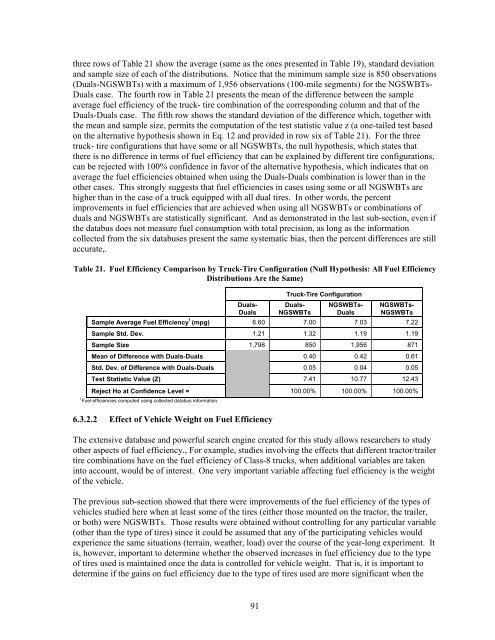Class-8 Heavy Truck Duty Cycle Project Final Report - Center for ...
Class-8 Heavy Truck Duty Cycle Project Final Report - Center for ...
Class-8 Heavy Truck Duty Cycle Project Final Report - Center for ...
You also want an ePaper? Increase the reach of your titles
YUMPU automatically turns print PDFs into web optimized ePapers that Google loves.
three rows of Table 21 show the average (same as the ones presented in Table 19), standard deviation<br />
and sample size of each of the distributions. Notice that the minimum sample size is 850 observations<br />
(Duals-NGSWBTs) with a maximum of 1,956 observations (100-mile segments) <strong>for</strong> the NGSWBTs-<br />
Duals case. The fourth row in Table 21 presents the mean of the difference between the sample<br />
average fuel efficiency of the truck- tire combination of the corresponding column and that of the<br />
Duals-Duals case. The fifth row shows the standard deviation of the difference which, together with<br />
the mean and sample size, permits the computation of the test statistic value z (a one-tailed test based<br />
on the alternative hypothesis shown in Eq. 12 and provided in row six of Table 21). For the three<br />
truck- tire configurations that have some or all NGSWBTs, the null hypothesis, which states that<br />
there is no difference in terms of fuel efficiency that can be explained by different tire configurations,<br />
can be rejected with 100% confidence in favor of the alternative hypothesis, which indicates that on<br />
average the fuel efficiencies obtained when using the Duals-Duals combination is lower than in the<br />
other cases. This strongly suggests that fuel efficiencies in cases using some or all NGSWBTs are<br />
higher than in the case of a truck equipped with all dual tires. In other words, the percent<br />
improvements in fuel efficiencies that are achieved when using all NGSWBTs or combinations of<br />
duals and NGSWBTs are statistically significant. And as demonstrated in the last sub-section, even if<br />
the databus does not measure fuel consumption with total precision, as long as the in<strong>for</strong>mation<br />
collected from the six databuses present the same systematic bias, then the percent differences are still<br />
accurate,.<br />
Table 21. Fuel Efficiency Comparison by <strong>Truck</strong>-Tire Configuration (Null Hypothesis: All Fuel Efficiency<br />
Distributions Are the Same)<br />
Sample Average Fuel Efficiency 1 (mpg)<br />
Duals-<br />
Duals<br />
<strong>Truck</strong>-Tire Configuration<br />
Duals-<br />
NGSWBTs<br />
NGSWBTs-<br />
Duals<br />
NGSWBTs-<br />
NGSWBTs<br />
6.60 7.00 7.03 7.22<br />
Sample Std. Dev. 1.21 1.32 1.19 1.19<br />
Sample Size 1,798 850 1,956 871<br />
Mean of Difference with Duals-Duals 0.40 0.42 0.61<br />
Std. Dev. of Difference with Duals-Duals 0.05 0.04 0.05<br />
Test Statistic Value (Z) 7.41 10.77 12.43<br />
Reject Ho at Confidence Level =<br />
1<br />
Fuel efficiencies computed using collected databus in<strong>for</strong>mation.<br />
6.3.2.2 Effect of Vehicle Weight on Fuel Efficiency<br />
100.00% 100.00% 100.00%<br />
The extensive database and powerful search engine created <strong>for</strong> this study allows researchers to study<br />
other aspects of fuel efficiency., For example, studies involving the effects that different tractor/trailer<br />
tire combinations have on the fuel efficiency of <strong>Class</strong>-8 trucks, when additional variables are taken<br />
into account, would be of interest. One very important variable affecting fuel efficiency is the weight<br />
of the vehicle.<br />
The previous sub-section showed that there were improvements of the fuel efficiency of the types of<br />
vehicles studied here when at least some of the tires (either those mounted on the tractor, the trailer,<br />
or both) were NGSWBTs. Those results were obtained without controlling <strong>for</strong> any particular variable<br />
(other than the type of tires) since it could be assumed that any of the participating vehicles would<br />
experience the same situations (terrain, weather, load) over the course of the year-long experiment. It<br />
is, however, important to determine whether the observed increases in fuel efficiency due to the type<br />
of tires used is maintained once the data is controlled <strong>for</strong> vehicle weight. That is, it is important to<br />
determine if the gains on fuel efficiency due to the type of tires used are more significant when the<br />
91
















